If you’re looking for a colorful and unique addition to your aquarium, the clown loach might be just what you need. These playful fish are known for their bright colors, interesting patterns, and social behavior. But before you bring one home, it’s important to understand the basics of clown loach care.
Clown loaches require a well-maintained aquarium with suitable water conditions, a varied diet, and a peaceful environment. They need a pH range of 6.0-7.5 and a temperature range between 75-86°F. The aquarium should be planted, and regular water changes should be performed to ensure their health. They are social and active fish, making them best suited for larger community tanks.
From water parameters to feeding habits, we’ll cover everything you need to know about keeping your clown loach happy and healthy. As someone who has kept clown loaches for years, I can attest to the joy they bring to any tank. But they do require specific care, and this article will provide all the information you need to make an informed decision about adding a clown loach to your aquatic family.
In this article, we’ll discuss the ideal tank setup for clown loaches, including water temperature, pH levels, and filtration requirements. We’ll also cover feeding habits, including the types of food that are best for these fish, and how often you should feed them. Finally, we’ll touch on some common health issues that clown loaches can experience, and how to prevent and treat them. So let’s dive in!
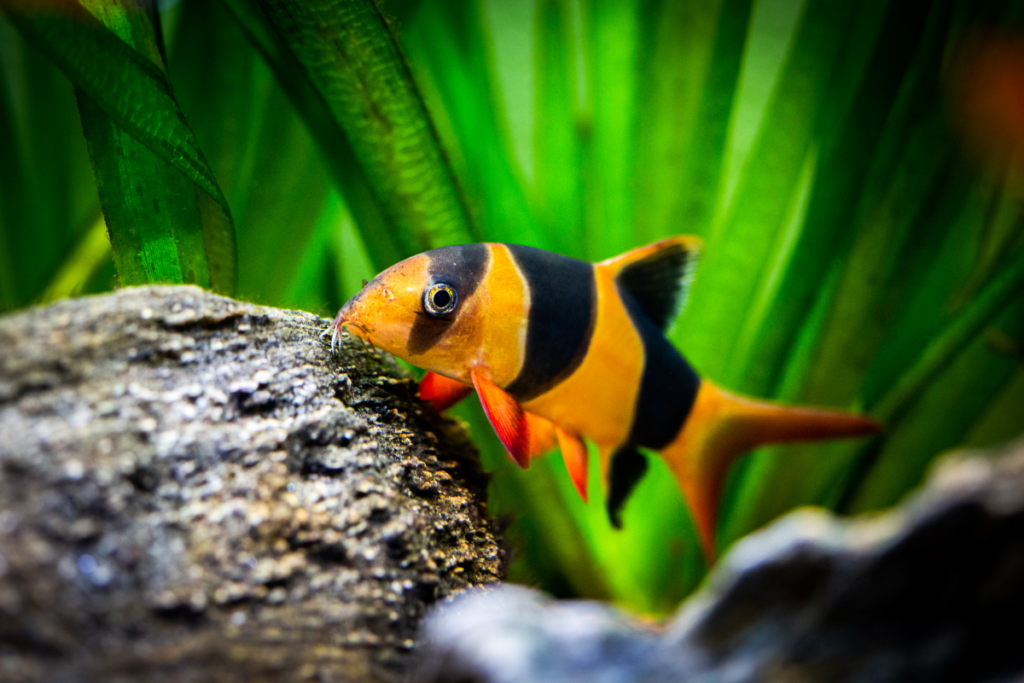
Table of Contents
Species Summary
Origin
The Clown Loach (botanical name Chromobotia macracanthus) is a freshwater fish that is native to Indonesia and Borneo. They are typically found in the clear, slow-moving rivers and streams of these regions.
Lifespan
Clown Loaches can live up to 20 years in the wild, but in captivity, they typically live for 10-15 years. A healthy diet and proper care can help extend their lifespan.
Appearance
These fish are known for their striking appearance, with bright orange and black stripes running the length of their bodies.
They have long, barb-like whiskers on their faces, which they use to sense their surroundings. Their bodies are cylindrical in shape, and they have a distinctive spine underneath their eyes.
Size
Clown Loaches can grow up to 12 inches in length, although they typically reach around 6-8 inches in captivity. They are a fairly large fish and require a spacious aquarium to thrive.
Growth rate
Clown Loaches grow relatively quickly, especially during their first year of life. However, their growth rate will slow down as they age, and they will eventually reach their full size.
Behavior & Temperament
Clown Loaches are social fish that thrive in groups of three or more. They are active and playful, and they enjoy exploring their surroundings.
These fish are known for their playful behavior, and they will often chase each other around the aquarium.
They are generally peaceful and get along well with other fish, although they may become territorial during breeding season.
Personally, I have found that Clown Loaches are fascinating fish to watch. They have a lot of personality and are always up to something.
I have a group of three in my aquarium, and they are always chasing each other around and playing hide-and-seek in the plants. I highly recommend them to anyone looking for an entertaining and visually striking addition to their aquarium.
Habitat Requirements
Clown loaches are freshwater fish that require a specific environment to thrive. Here are the key elements to consider when setting up their habitat:
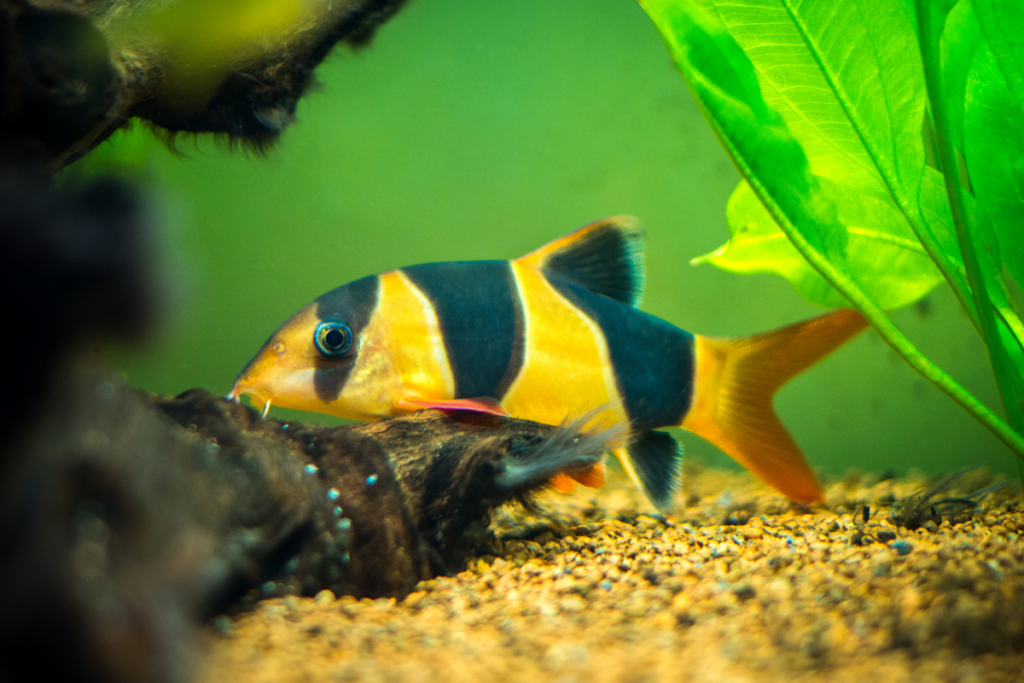
Tank Size
Clown loaches are active swimmers and can grow up to 12 inches long, so they need plenty of space to move around.
A minimum tank size of 75 gallons is recommended for a group of 4-6 adult clown loaches. Make sure the tank is long enough to accommodate their swimming habits.
Lighting
Clown loaches prefer low to moderate lighting, as bright light can stress them out. A timer can be used to regulate the lighting cycle and provide a natural day-night rhythm.
Filtration & Aeration
Good filtration is essential to maintain a healthy environment for clown loaches.
A canister filter or a sump system is recommended to keep the water clean and well-oxygenated. Aeration is also important to ensure a steady supply of oxygen for the fish.
Heater
Clown loaches are tropical fish and require a water temperature of 75-86°F. A reliable heater is essential to maintain a consistent temperature in the tank.
Substrate
Clown loaches are bottom-dwellers and prefer a soft substrate that won’t damage their delicate barbels. Sand or fine gravel is a good choice, as it also allows for natural digging behavior.
Decoration
Clown loaches are playful and curious fish that enjoy exploring their environment. Adding caves, tunnels, and other hiding spots will provide them with a sense of security and stimulation.
Plants
Clown loaches are known to uproot plants, so it’s important to choose hardy species that can withstand their antics. Java fern, Anubias, and Amazon sword are good options.
Floating plants like water lettuce and water hyacinth can also provide shade and cover.
When setting up a habitat for clown loaches, it’s important to consider their specific requirements and provide a comfortable and stimulating environment.
I remember when I first got my clown loaches, I was amazed by their playful behavior and how they would swim through the tunnels and hide in the caves.
Creating a suitable habitat for them not only ensures their well-being but also allows you to observe their fascinating behavior up close.
Water Conditions
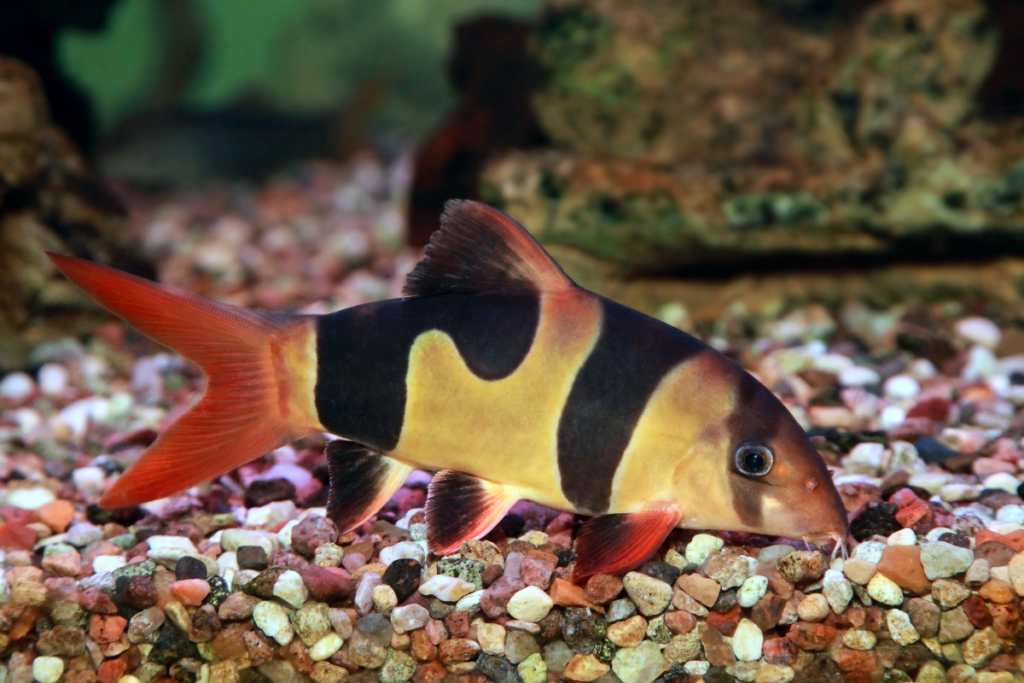
Water Temperature
Clown loaches are tropical fish and require a water temperature of 75-86°F (24-30°C). I recommend keeping the water temperature at around 78°F (26°C) to ensure your clown loaches stay healthy and active.
Water pH
The ideal pH range for clown loaches is between 6.5-7.5. It’s important to maintain a stable pH level to prevent stress and disease. I use a pH test kit to monitor the pH level and adjust it as needed.
Water Hardness
Clown loaches prefer soft to moderately hard water with a hardness level of 5-12 dGH. I recommend using a water hardness test kit to make sure the water is within the acceptable range.
Water Changes
Regular water changes are essential for maintaining good water quality and keeping your clown loaches healthy. I recommend changing 25% of the water every week.
When doing water changes, make sure the new water is at the same temperature and pH level as the tank water.
Overall, maintaining proper water conditions is crucial for the health and well-being of your clown loaches.
By monitoring and adjusting the water temperature, pH, and hardness, and performing regular water changes, you can ensure your clown loaches thrive in their environment.
Personally, I have found that keeping the water temperature at 78°F (26°C) and performing weekly water changes has helped keep my clown loaches healthy and happy.
I always look forward to feeding time when they come out of hiding and swim around playfully.
Tank Mates
Clown loaches are social creatures and thrive in groups, but it’s important to choose tank mates carefully to ensure a peaceful and healthy environment. Here are some compatible tank mates for your clown loaches:
- Tetras
- Corydoras
- Dwarf Gouramis
- Otocinclus
- Harlequin Rasboras
These fish are all peaceful and won’t compete with clown loaches for food or territory.
However, it’s important to note that clown loaches can grow quite large, so avoid keeping them with small fish that could be seen as prey.
I personally have had success keeping clown loaches with a group of rainbowfish. The rainbowfish are larger and faster than the clown loaches, so they don’t see them as prey.
Plus, the colors of the rainbowfish really pop against the brown and orange of the clown loaches.
Remember, it’s always best to research the specific needs of any fish you plan to keep with clown loaches to ensure a happy and healthy tank environment.
How Many Clown Loaches Should Be Kept Together?
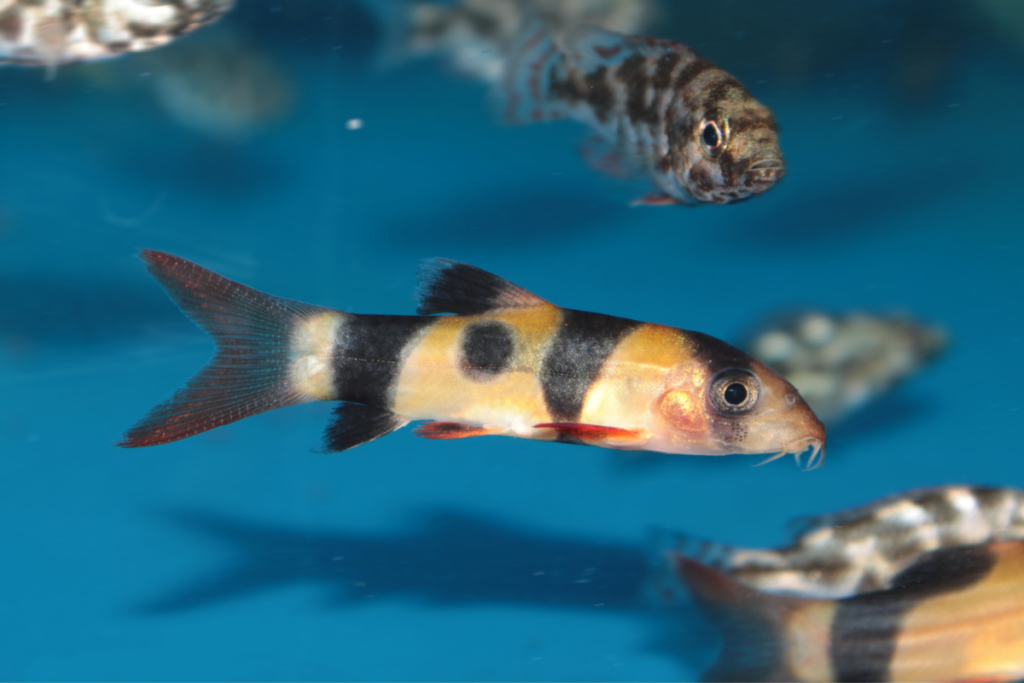
Clown loaches are social fish and should be kept in groups of at least 6 individuals. These fish are happiest when kept in schools, and they will often form a hierarchy within the group.
If you keep only one or two clown loaches, they may become stressed and exhibit aggressive behavior towards other fish in the tank.
When determining how many clown loaches to keep together, it is important to consider the size of your aquarium.
These fish can grow up to 12 inches in length, so you will need a large tank to accommodate a group of them. A general rule of thumb is to have at least 30 gallons of water for every 3-4 clown loaches.
In my experience, I have found that keeping a group of 6-8 clown loaches together in a 75-gallon tank is ideal.
This provides plenty of swimming space for the fish and allows them to establish their hierarchy without overcrowding the tank.
It is also important to note that clown loaches are active fish that enjoy exploring their environment. Providing plenty of hiding places, such as caves and plants, can help reduce stress and aggression in the group.
Overall, keeping a group of clown loaches together can be a rewarding experience for both the fish and the fishkeeper.
By providing a suitable environment and companionship, you can ensure that your clown loaches thrive and exhibit their natural behaviors.
Feeding
Feeding your clown loaches is an essential part of their care. A well-fed clown loach is a happy and healthy clown loach.
In this section, we will discuss the diet, feeding frequency, and feeding tips for your clown loach.
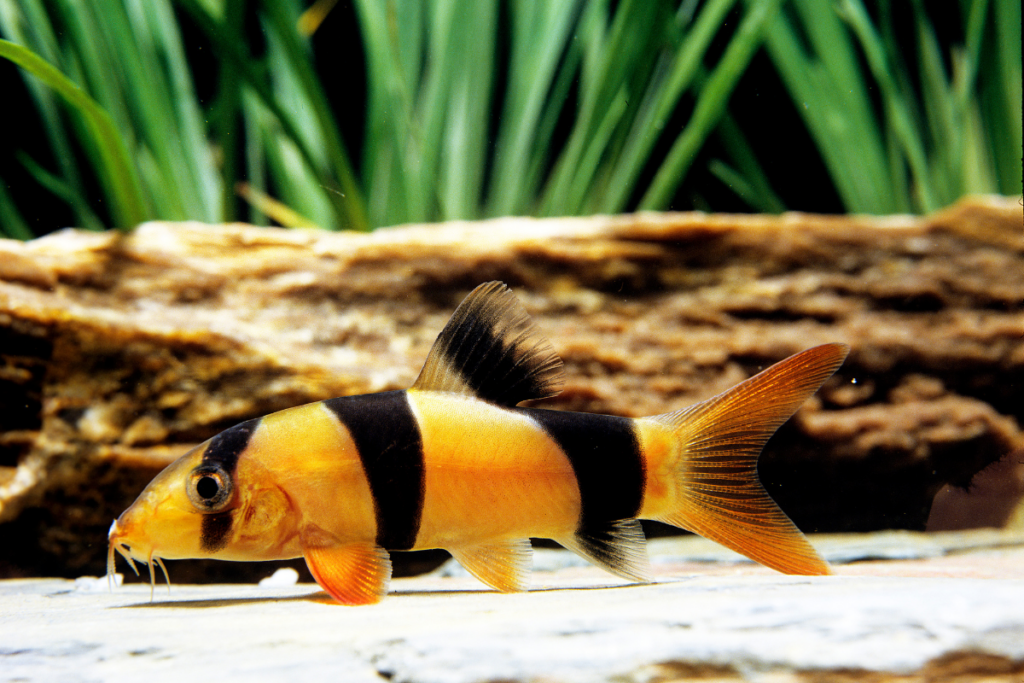
Diet
Clown loaches are omnivores and will eat a variety of foods. In the wild, they feed on insects, crustaceans, and small fish.
In captivity, you should feed them a varied diet that includes both plant and animal matter. Pellets, flakes, frozen or live foods such as brine shrimp, bloodworms, and daphnia are all excellent choices.
Feeding Frequency
Clown loaches should be fed twice a day, once in the morning and once in the evening. Feed only what your fish can consume in 2-3 minutes.
Overfeeding can lead to health problems such as obesity and poor water quality.
Feeding Tips
When feeding your clown loaches, it is important to remember a few tips. First, make sure the food you are feeding them is fresh and of high quality. Second, vary their diet to ensure they are getting all the necessary nutrients.
Third, consider using a feeding ring or target feeding to ensure all your fish get their fair share of food. Finally, remove any uneaten food after feeding to prevent it from fouling the water.
Personally, I have found that my clown loaches love frozen bloodworms. I like to soak them in a small amount of tank water for a few minutes before feeding to soften them up. They go crazy for them and it’s a joy to watch them eat.
Health
Common Diseases
Clown loaches are generally hardy fish, but they can still be susceptible to certain diseases.
One of the most common diseases that affect clown loaches is Ich, which is caused by a parasite. Other diseases that may affect clown loaches include fin rot, swim bladder disease, and dropsy.
Symptoms
It’s important to keep an eye on your clown loaches to catch any potential health issues early. Symptoms of Ich include white spots on the fish’s body and fins, while fin rot can cause the fins to appear frayed or ragged.
Swim bladder disease may cause the fish to have difficulty swimming, and dropsy can cause the fish to have a swollen abdomen.
Treatment
If you notice any symptoms of disease in your clown loaches, it’s important to take action quickly. There are a variety of treatments available, depending on the specific disease.
For Ich, you may need to treat the water with medication or raise the temperature of the tank.
Fin rot can often be treated with antibiotics, while swim bladder disease may require a change in diet or water conditions. Dropsy can be more difficult to treat, and in some cases, may be fatal.
Personally, I once had a clown loach that developed Ich. I treated the tank with medication and raised the temperature, and within a week, the fish had made a full recovery.
It’s important to act quickly and keep a close eye on your fish’s health to ensure they stay happy and healthy.
Signs of a Healthy Clown Loach
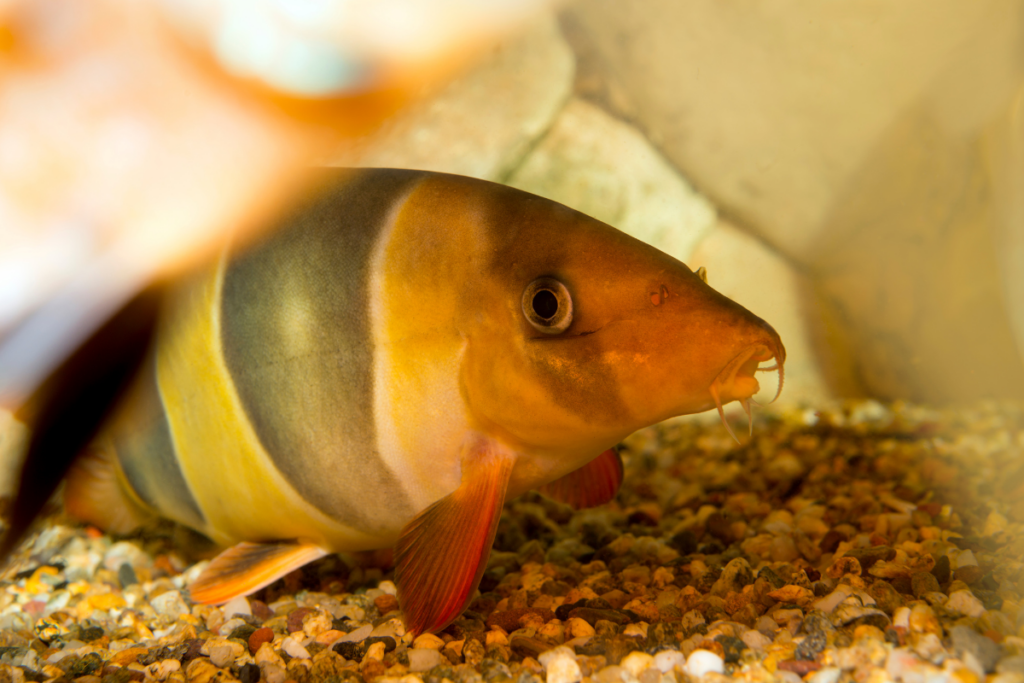
As an aquarium owner, it is important to know the signs of a healthy clown loach. Here are a few things to look out for:
- Active and playful behavior
- Clear and bright eyes
- Smooth and shiny skin
- Good appetite and regular feeding habits
- Regular and healthy waste elimination
When I first got my clown loach, I was worried about whether it was healthy or not. But after observing its behavior and appearance, I was relieved to see that it was active, had bright eyes, and smooth skin. It also had a good appetite and regularly eliminated waste.
These signs are a good indication that your clown loach is healthy and happy in its environment.
However, it is important to note that not all signs of an unhealthy clown loach are visible. Sometimes, they may appear healthy on the outside but have internal issues.
That’s why it’s important to maintain a clean and healthy tank environment and monitor your clown loach’s behavior and eating habits regularly.
Signs of a Sick Clown Loach
If you’re a proud owner of a clown loach, you know how important it is to keep them healthy and happy. However, sometimes even with the best care, your loach can become ill. Here are some signs to look out for:
- Loss of appetite
- Lethargy or sluggishness
- Abnormal swimming patterns
- Visible parasites or white spots on the skin
- Red or inflamed gills
If you notice any of these symptoms, it’s important to take action quickly. Sick fish can deteriorate rapidly, and early detection and treatment can make all the difference.
One time, I noticed that my clown loach, Bubbles, was acting strange. He was usually very active and playful, but he seemed to be hiding in the corner of the tank and not eating.
I was worried, so I did some research and discovered that he might be suffering from a bacterial infection.
I immediately took him to the vet, who prescribed some medication. After a week of treatment, Bubbles was back to his old self, swimming around and eating with gusto.
Remember, prevention is always better than cure. Keep your tank clean and well-maintained, and make sure your clown loach has plenty of space to swim and play.
And if you do notice any signs of illness, don’t hesitate to seek professional help.
Breeding
If you’re interested in breeding clown loaches, it’s important to understand their behavior, setup requirements, and fry care. Here are some tips to help you successfully breed your clown loaches.
Breeding Behavior
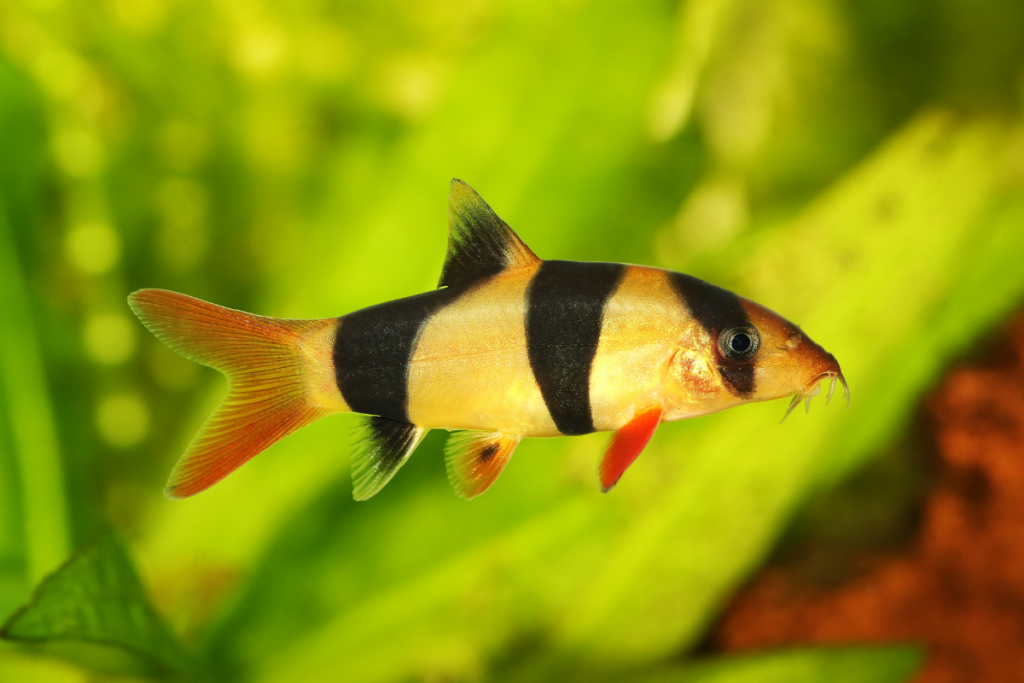
Clown loaches are egg-layers, and breeding usually occurs during the rainy season. Males will chase females around the tank, and once a pair has formed, they will engage in courtship behavior.
This involves the male swimming around the female, nudging her gently, and sometimes even performing a dance.
I’ve found that it’s important to provide plenty of hiding places for the female during this time, as the male can become aggressive towards her.
I like to use PVC pipes or breeding cones, which allow the female to retreat and lay her eggs in peace.
Breeding Setup
If you’re serious about breeding clown loaches, you’ll need to set up a separate breeding tank. This tank should be at least 20 gallons and have a sponge filter to provide gentle filtration.
You’ll also need to provide plenty of hiding places for the female, as well as a spawning mop or breeding cone for her to lay her eggs on.
I’ve found that a water temperature of around 78-82°F and a pH of 6.5-7.5 is ideal for breeding clown loaches. You should also perform frequent water changes to keep the water clean and healthy for your fish.
Fry Care
Once the eggs have hatched, you’ll need to provide special care for the fry. They are very small and delicate, and can easily be sucked up by a filter or eaten by other fish in the tank.
To keep them safe, I like to use a bare-bottom tank with a sponge filter. I feed them small amounts of powdered food several times a day, and perform frequent water changes to keep the water clean and healthy.
It’s important to keep a close eye on the fry during this time, as they can be prone to disease and other health issues.
Overall, breeding clown loaches can be a rewarding experience for the dedicated fishkeeper. With the right setup and care, you can successfully raise a new generation of these fascinating fish.
Personally, I’ve found that breeding clown loaches is a great way to connect with my fish on a deeper level. Watching the courtship behavior and caring for the fry is a truly unique experience that has brought me closer to my pets.
Recommended Products:
- Fluval FX4 High Performance Aquarium Filter – This canister filter is recommended for maintaining good filtration and keeping the water clean for clown loaches.
- Aqueon Pro 300W Submersible Aquarium Heater – This reliable heater is essential for maintaining a consistent temperature in the tank.
- Seachem Flourite Black Clay Gravel – This substrate is perfect for bottom-dwelling clown loaches as it is soft and won’t damage their delicate barbels.
- Penn-Plax Hideaway Pipes Aquarium Decoration – Adding caves and tunnels provides clown loaches with a sense of security and stimulation.
- Anubias Nana Petite on Driftwood – This hardy plant is a good option for clown loach tanks as they are known to uproot plants.
- TetraMin Plus Tropical Flakes – This high-quality fish food is a good option for feeding clown loaches as they are omnivores and will eat a variety of foods.
- API Freshwater Master Test Kit – This test kit is recommended for monitoring the pH and water hardness levels to maintain a stable environment.
- Hikari USA Bio-Pure Freeze Dried Blood Worms – This freeze-dried food is a favorite of clown loaches and is a good option for adding variety to their diet.
- Fluval Plant and Shrimp Stratum – This substrate is another good option for bottom-dwelling clown loaches as it allows for natural digging behavior.
- Marina LED Aquarium Kit – This kit includes low to moderate lighting, which is preferred by clown loaches as bright light can stress them out. The timer can also be used to regulate the lighting cycle and provide a natural day-night rhythm.
Conclusion
It’s been a pleasure sharing everything you need to know about clown loach care with you. These amazing fish are fascinating creatures that can bring joy and excitement to your aquarium.
If you’re considering adding clown loaches to your tank, I highly recommend it.
Through my personal experience, I’ve found that clown loaches are incredibly social and intelligent fish. They have unique personalities and will often interact with their owners, recognizing them as a source of food and companionship.
Remember, proper care is essential to keeping your clown loaches healthy and happy. Make sure you provide them with a spacious aquarium, clean water, and a varied diet. Avoid overfeeding and keep an eye out for any signs of illness.
Overall, I hope this guide has been helpful in providing you with the knowledge and confidence to care for your clown loaches. With a little effort and attention, these beautiful fish can thrive in your aquarium for years to come.
FAQs
Here are some frequently asked questions about clown loach care:
Q: How often should I feed my clown loaches?
A: Clown loaches are omnivores and should be fed a varied diet of pellets, flakes, frozen foods, and live foods. Feed them once or twice a day, only giving them as much food as they can eat in a few minutes. Overfeeding can lead to health issues and poor water quality.
Q: Can I keep clown loaches with other fish?
A: Yes, clown loaches are generally peaceful and can be kept with other non-aggressive fish. However, they can be territorial and may fight with other clown loaches or fish of similar size and shape. It’s best to keep them in groups of at least three to reduce stress and aggression.
Q: How big do clown loaches get?
A: Clown loaches can grow up to 12 inches in length, although they usually only reach 6-8 inches in home aquariums. Make sure you have a large enough tank to accommodate their size and provide plenty of hiding places and swimming space.
Q: Do clown loaches require special water conditions?
A: Clown loaches prefer slightly acidic to neutral water with a pH range of 6.5-7.5. They also require good water flow and oxygenation. Regular water changes and a well-maintained filter are essential for their health and well-being.
My personal anecdote:
I have a group of three clown loaches in my 75-gallon tank, and they are some of my favorite fish. They have such unique personalities and are always active and playful. I love watching them explore their environment and interact with each other. Taking care of them has been a rewarding experience, and I highly recommend them to any fishkeeper looking for a fun and interesting addition to their tank.
Reference: Wikipedia.
